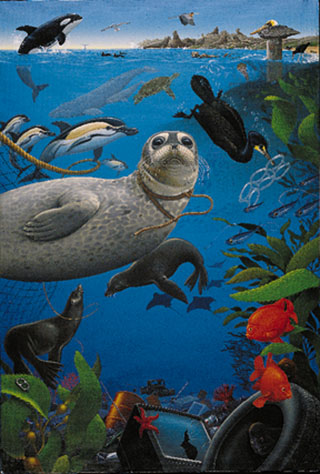Want to engage your students in a series of science and math based hands-on activities that really make a difference? Then dive into SAVE OUR SEAS, a set of K-12 curriculum materials for your classroom written in 1993 by the California Coastal Commission and the Center for Marine Conservation (now know as The Ocean Conservancy).

Save Our Seas is specifically designed to implement the concepts and approaches embodied in the California Science Framework as well as other teaching frameworks adopted by the California State Board of Education.
Save Our Seas is divided into four units: grades K-3, 4-6, 7-8, and 9-12. Each unit addresses why we should care about the marine environment, the ocean pollution problem and how individuals can be part of the solution. (The 9-12 unit has been updated and is available as the "Community Action" chapter in the Waves, Wetlands, and Watersheds science activity guide. You can download it in PDF form, with related appendices.
The K-6 sections integrate multiple subjects including science, math, geography, social science, language arts, and art. The 7-12 section is focused on science classes, yet still integrates social issues. Secondary level students learn field methods and techniques while analyzing the marine debris problem. Participation in a waterway or beach cleanup is encouraged in each unit with step by step procedures provided.
The curriculum is designed to encourage students to think about the complexity of environmental problems and assess the information available before making decisions. The activities take a hands on approach to current environmental issues and are designed to help students make personal choices and realize the individuals potential to create positive and effective changes in society. Each unit concludes with a success story about what students of all ages are doing to protect our Earth.
The introduction to each activity includes the recommended grade level, major subjects from which the concepts are drawn, major concepts covered in the activity, skills, estimated duration, setting (indoors or outdoors), and key vocabulary.
Each activity also includes the objective(s) of the activity, the method employed, background information for the instructor, materials needed, step-by-step procedures, suggested means of assessing the students' comprehension of the material, at-home learning activities, extension activities, and the original source of the activity or information.
The Appendices include handouts required in multiple activities, a play about marine debris that can be used as an extension activity, a list of resources that includes agencies and organizations referred to in one or more of the activities, other available marine debris materials, and a glossary.